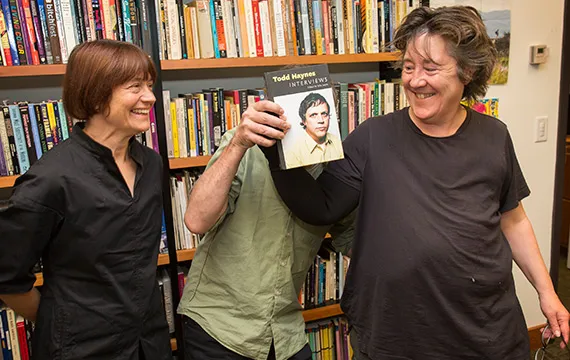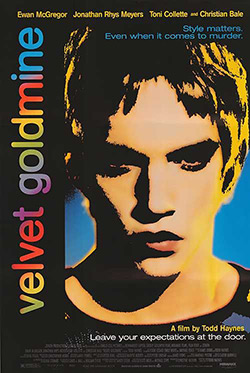Protecting the Vision

From left, Professor of Film and Media Studies Patricia White, writer/director Todd Haynes, and producer Christine Vachon
On the verge of graduating from college, Christine Vachon had “no idea” what would come next. But that was okay.
“I didn’t have it in my head that this is the kind of job I have to get with this degree, or that if I don’t follow a certain trajectory I have failed,” says the renowned producer of such films as Far From Heaven and I’m Not There. “I knew that I wanted to be a part of the film world, so I just walked through whatever door was open.”
“Get yourself in the universe,” she adds, “even if it’s not the exact slice of that universe that you think you need to be in.”
Vachon imparted that advice to students in her master class on independent film producing held recently at Swarthmore, before taking them behind the scenes of a production. Hours later, Academy Award-nominated writer/director Todd Haynes discussed his political vision and aesthetic process and ruminated on the future of film with the College community.
Long-time friends and collaborators, Vachon and Haynes worked together on the afore-mentioned films and Velvet Goldmine, among others, as well as the Emmy Award winning miniseries Mildred Pierce.
“Their collaboration is something special,” says Patricia White, professor and chair of the Department of Film & Media Studies, which sponsored the filmmakers’ appearances along with the Sager Fund. “Christine and her company produce a lot of auteur directors like Todd with unique visions — and they protect that vision, which is rare.”

As part of his campus visit, Haynes screened Velvet Goldmine, which won an award for Best Artistic Contribution in the main competition of the Cannes Film Festival in 1998.
Vachon and Haynes helped to launch the New Queer Cinema movement in 1991 with Poison, says White, becoming "models of visionary indie filmmaking.”
“They stay true to their politics, theoretical approach, and LGBT sensibilities,” she says.
Bringing the filmmakers to campus together was a “major achievement,” says White, who counts them as friends. Not only because of their stature but because they are on tight post-production deadlines for their forthcoming film, Carol.
Haynes and Vachon had visited the College in the past, but White was eager to bring them back to interact with Film & Media Studies students, in particular. The new department, which was an interdisciplinary program until 2011, offers students an experience similar to the one Haynes and Vachon had as classmates at Brown University.
“We’re really trying to develop a curriculum that instills not only the history of the film but also theories and politics of media,” says White, “blending creativity and experimentation with hands-on production.”
White has often presented the filmmakers’ work to students, including this semester for her course (which is cross-listed with Gender & Sexuality Studies) on queer media. The opportunity to meet and talk shop with the artists they are studying delighted the students.
“I really appreciate how deeply grounded in theory [Hayne’s] work is,” says Allison Hrabar ’16, of Tucson, Ariz., an avid fan of the director since seeing his work in her first-year seminar.
“The films are gorgeous and entertaining but also exciting to study,” she says. “And the subjects they address — queerness, feminist examinations of periods like the 1950s and 1960s, and ‘deviant’ individuals — are favorites of mine.”
Also excited was Assistant Professor of History Farid Azfar, who says he was “obsessed” with Velvet Goldmine and Far From Heaven before he even knew they came from the same creators. Searching for connections among them, he returns to a line that flashes in Velvet: “Meaning is not in things but in between them.”
“That quote, for me, is way of understanding what each of these films is doing, how they are all zoning into the in-between spaces, fearlessly exploring these secret, hidden regions of human experience,” he says, “where people are excluded, divided, trapped, or otherwise live in states of separation, from the world around them or from themselves.
“I think this oeuvre is an inspiring example of how we can model education at Swarthmore," Azfar adds, "and of what can happen when we summon the moral and intellectual courage to look at the world from the eyes of the outcast."



